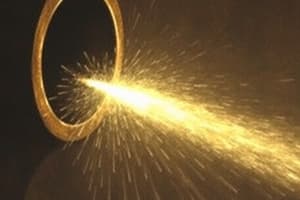Podcast
Questions and Answers
The pattern for an inclusion is a magnetic particle buildup forming
The pattern for an inclusion is a magnetic particle buildup forming
- a fern like pattern.
- parallel lines. (correct)
- a single line.
The main purpose of magnetic particle inspection is to identify
The main purpose of magnetic particle inspection is to identify
- flaws on or near the surface. (correct)
- distortion.
- deep subsurface flaws.
In magnetic particle inspection, a part will be categorized as having a fatigue crack under what circumstance?
In magnetic particle inspection, a part will be categorized as having a fatigue crack under what circumstance?
- The discontinuity pattern is straight.
- The discontinuity is found in a highly stressed area of the part (correct)
- The discontinuity is found in a non-stressed area of the part.
Which materials among the following can be examined using the magnetic particle inspection technique?
Which materials among the following can be examined using the magnetic particle inspection technique?
Which of the following materials may be inspected using the magnetic particle inspection method?
1.Copper alloys.
2.Zinc alloys.
3.Aluminum alloys.
4.Magnesium alloys.
5.Iron alloys.
Which of the following materials may be inspected using the magnetic particle inspection method? 1.Copper alloys. 2.Zinc alloys. 3.Aluminum alloys. 4.Magnesium alloys. 5.Iron alloys.
In magnetic particle inspection, a defect that runs at a right angle to the lines of the magnetic field typically results in
In magnetic particle inspection, a defect that runs at a right angle to the lines of the magnetic field typically results in
During the examination of an item using the magnetic particle inspection technique, both circular and longitudinal magnetization should be applied to...
During the examination of an item using the magnetic particle inspection technique, both circular and longitudinal magnetization should be applied to...
What types of defects can be identified through the application of circular magnetization on a component?
What types of defects can be identified through the application of circular magnetization on a component?
What flaws can be identified through the use of continuous longitudinal magnetization using a cable when inspecting a component?
What flaws can be identified through the use of continuous longitudinal magnetization using a cable when inspecting a component?
Which statement about the residual magnetizing inspection technique is correct?
Which statement about the residual magnetizing inspection technique is correct?
After conducting magnetic particle inspection, a method to demagnetize a component involves
After conducting magnetic particle inspection, a method to demagnetize a component involves
In magnetic particle inspection, the testing substance commonly employs a ferromagnetic material that possesses what characteristic?
In magnetic particle inspection, the testing substance commonly employs a ferromagnetic material that possesses what characteristic?
For X-ray exposure, how many of these factors are regarded as fundamental knowledge?
1.Processing of the film.
2.Material thickness and density.
3.Exposure distance and angle.
4.Film characteristics.
For X-ray exposure, how many of these factors are regarded as fundamental knowledge? 1.Processing of the film. 2.Material thickness and density. 3.Exposure distance and angle. 4.Film characteristics.
Which of the provided techniques could be appropriate for identifying surface-open cracks in aluminum forgings and castings?
1.Visual inspection.
2.Eddy current inspection.
3.Dye penetrant inspection.
4.Metallic ring (coin tap) inspection.
5.Ultrasonic inspection.
6.Magnetic particle inspection.
Which of the provided techniques could be appropriate for identifying surface-open cracks in aluminum forgings and castings? 1.Visual inspection. 2.Eddy current inspection. 3.Dye penetrant inspection. 4.Metallic ring (coin tap) inspection. 5.Ultrasonic inspection. 6.Magnetic particle inspection.
Flashcards are hidden until you start studying




